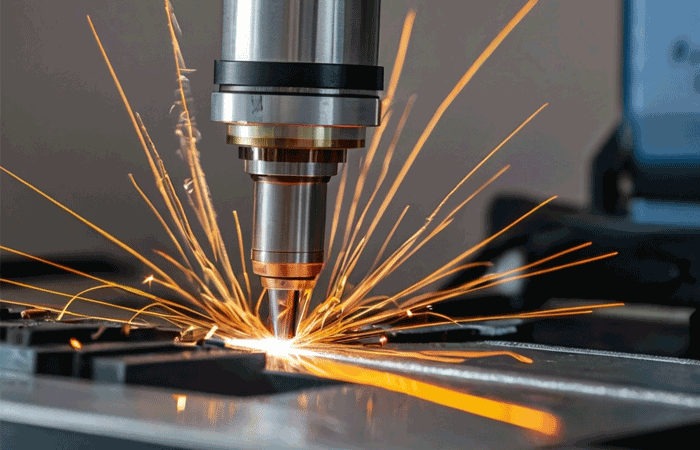Integrating Process Weld Monitoring Features In Laser Welding Systems
For Smart Automotive Manufacturing
 As the automotive industry transitions towards electrification, the demand for innovative manufacturing solutions has never been more pressing. The integrity of the welds is paramount to ensure the safety, durability and performance of vehicles, batteries and powertrains. Even a single defective weld can lead to structural weakness, component failure, and safety hazards, posing significant risks to both manufacturers and consumers. Addressing these challenges requires advanced process monitoring features in welding technologies capable of delivering precise, reliable, and high-quality welds consistently.
As the automotive industry transitions towards electrification, the demand for innovative manufacturing solutions has never been more pressing. The integrity of the welds is paramount to ensure the safety, durability and performance of vehicles, batteries and powertrains. Even a single defective weld can lead to structural weakness, component failure, and safety hazards, posing significant risks to both manufacturers and consumers. Addressing these challenges requires advanced process monitoring features in welding technologies capable of delivering precise, reliable, and high-quality welds consistently.
Modern day laser welding has emerged as a cornerstone technology, offering unparalleled precision and efficiency in joining components critical to electric vehicles (EVs) and traditional automotive applications. However, ensuring the quality and consistency of laser welds presents its own set of challenges.
This article delves into the integration of vision detection, seam tracking, and in-line weld monitoring in laser welding systems, elucidating their pivotal role in enhancing quality, reducing waste, and amplifying productivity in today’s automotive landscape.
Pioneering Solutions For Smart Manufacturing
Detecting welding defects is paramount to ascertain welding quality and ensure the mechanical robustness of joints. Any possible weld defect may affect the mechanical properties of the components, and as a result the risks of fatigue failure gets increased significantly. Most of common weld detection techniques are performed offline, are time consuming, and strongly dependent on the operator skill in recognizing and identifying defects.
Vision Detection:
A laser welding machine will perform welding operation only as it has been programmed weld as it doesn’t have an eye of its own. How well the machine is able to weld is totally dependent on the operator who has programmed it. The machine without an integrated vision system, typically will be welding blind-fold.
Integrating vision cameras is like giving eyes and intelligence to the laser welding machine to provide real-time insights into the welding process. By capturing high-resolution images of the work-piece and weld area, vision systems enable precise alignment of the laser beam within defined tolerances, ensuring optimal weld seam positioning. Moreover, advanced image processing algorithms helps analyse and detect visual defects like humping, blowholes, cracks and overflows.
This proactive approach to quality control minimizes rework and scrap, resulting in significant cost savings for manufacturers.
In-Line Weld Monitoring:
While vision detection offers a surface-level view of welds, in-line weld monitoring systems delve deeper, leveraging Optical Coherence Tomography (OCT) to unveil the intricacies of laser welds. This imaging technique is the only technology that delivers direct, geometric measurements of laser weld depth penetration during the weld.
By capturing cross-sectional images of the weld zone in real-time, OCT technology enables non-destructive evaluation of weld depth penetration which can detect under-penetration or over-penetration under defined tolerances to give a pass-fail criteria. The data is saved for each and every weld produced. Furthermore, it also facilitates process optimization, enabling manufacturers to fine-tune welding parameters for enhanced quality and efficiency.
This real-time feedback loop empowers operators to identify and rectify process deviations and sub-assembles promptly, mitigating the risk of defective parts entering the supply chain.
Seam Tracking:
Seam tracking technology has become indispensable for improving process stability and maintaining weld quality and consistency especially in complex automotive components. Seam tracking systems makes use of sensors to track the weld seam profile, detect deviations and adjust the laser beam trajectory in real-time to follow the intended path accurately. So basically, it rectifies weld positioning errors for difficult to weld geometries which helps in compensating imprecision and distortion.
By minimizing deviations and errors, seam tracking systems optimize welding parameters, maximizing productivity while guaranteeing adherence to stringent quality standards and reduce scraps for scalable and sustainable manufacturing.
Conclusion:
The integration of process monitoring features like vision detection, seam tracking, and in-line weld monitoring features in laser welding systems represents a transformative advancement in automotive manufacturing. By leveraging these technologies, manufacturers can overcome the inherent challenges associated with laser welding, including weld seam alignment, consistency, and quality assurance. Whether producing EV components or traditional automotive parts, the combination of these capabilities not only improves product quality but also reduces scrap rates and increases overall productivity.
As the automotive industry continues to evolve, embracing cutting-edge solutions like integrated process monitoring systems is essential for staying competitive in a rapidly changing landscape.
Article By

Shipra Sinha (Director – Marketing) is a seasoned expert in laser welding technology and is a pioneer leader at her company Light Mechanics, which is a leading manufacturer of specialized laser welding systems for automotive and EV applications. With over 13+ years of experience in the laser industry, Shipra is dedicated to driving innovation and excellence in automotive manufacturing through advanced Laser welding solutions.


